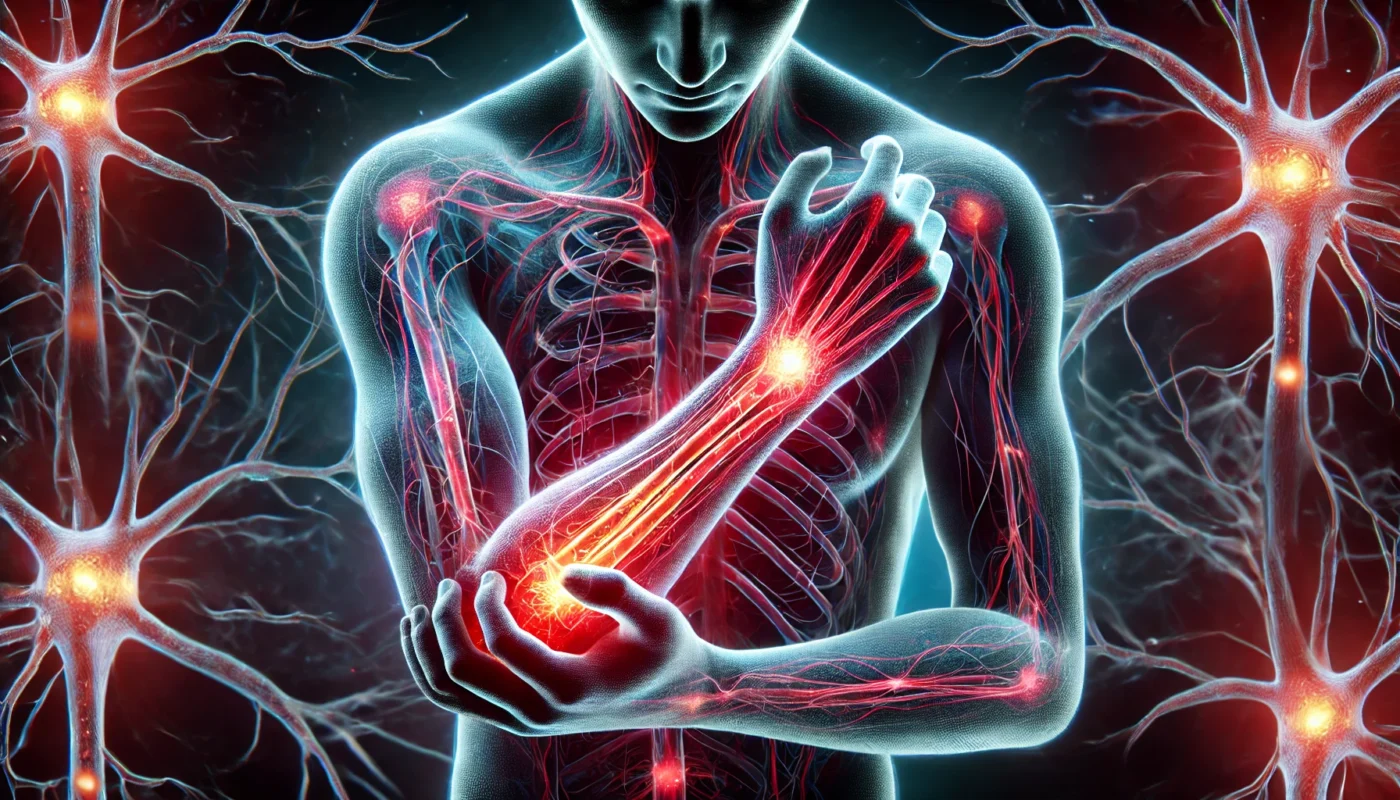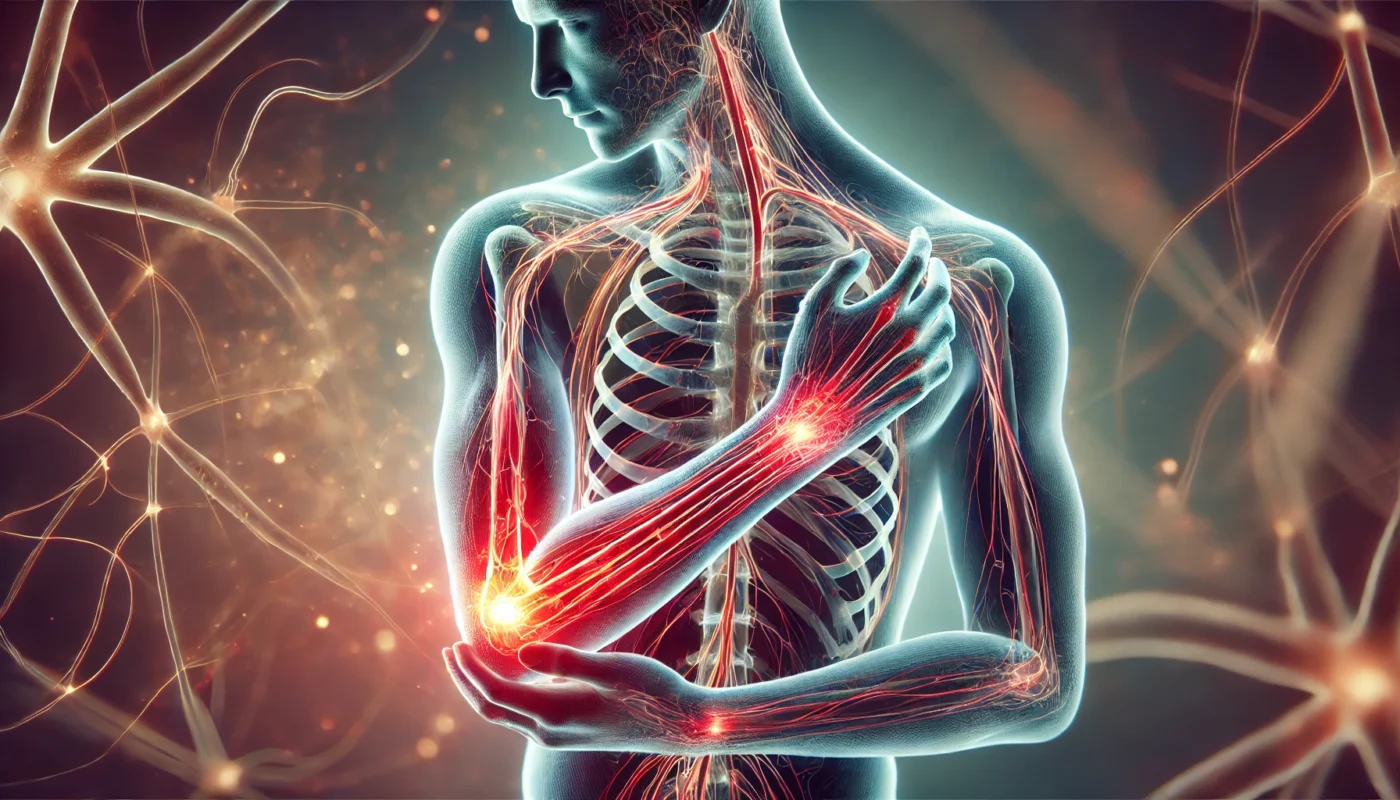Fibromyalgia, a complex chronic pain condition, affects millions worldwide. Characterized by widespread musculoskeletal pain, fatigue, and tenderness in localized areas, it can significantly impact daily life. Among its myriad symptoms, arm pain is notably challenging, often complicating ordinary tasks. This article explores the multifaceted nature of fibromyalgia arm pain, offering insights into its causes and management strategies. Whether you’re a fitness enthusiast, health advocate, or someone living with fibromyalgia, this guide aims to provide practical insights and solutions tailored to your needs.
You may also like: Exploring Alternative Treatments for Pain Relief
What Causes Arm Pain in Fibromyalgia?
Fibromyalgia arm pain stems from a combination of factors, including heightened pain sensitivity and the brain’s way of processing pain signals. This neurological disorder amplifies pain sensations, leading to discomfort even with minor stimuli. Understanding these causes is crucial for effective management.
The Science Behind the Pain
Understanding the science behind fibromyalgia is crucial. Research suggests that fibromyalgia involves abnormal pain perception processing in the central nervous system. This means that people with fibromyalgia feel pain differently than those without the condition.
Recent studies have identified potential neurotransmitter imbalances, particularly involving serotonin and norepinephrine, which play a role in mood regulation and pain perception. Consequently, this altered neurochemical balance may contribute to the chronic pain experienced in fibromyalgia.
Emerging research is also examining the role of genetics and environmental factors in fibromyalgia development. A genetic predisposition may interact with environmental triggers, such as infections or trauma, leading to the onset of fibromyalgia symptoms.
Trigger Points and Arm Pain
Fibromyalgia is also associated with tender points, which are specific areas of the body that are painful when pressed. In the arms, these points often include the elbows and upper arm muscles. This localized pain can exacerbate when engaging in activities that involve repetitive arm movements, such as typing or lifting.
In addition to tender points, muscle stiffness and spasms can contribute to arm pain in fibromyalgia. These symptoms may be more pronounced in the morning or after periods of inactivity, making daily tasks more challenging.
Muscle fatigue is another common issue, often resulting from disrupted sleep patterns that are prevalent in fibromyalgia. Poor sleep quality exacerbates muscle fatigue, making arm pain more persistent and difficult to manage.
Neurological Factors
Neurological factors play a crucial role in fibromyalgia arm pain. The brain’s altered processing of pain signals means that normal sensations, such as touch or pressure, are perceived as painful.
Central sensitization, a key feature of fibromyalgia, involves increased sensitivity to pain and a heightened response to stimuli. This can lead to a phenomenon known as “allodynia,” where non-painful stimuli cause pain, contributing to arm discomfort.
The role of the autonomic nervous system is also under investigation, with some studies suggesting dysregulation in this system may impact blood flow and muscle oxygenation, potentially exacerbating pain symptoms in the arms.
Managing Arm Pain: Holistic and Alternative Approaches
While there is no cure for fibromyalgia, various holistic and alternative strategies can aid in managing symptoms and improving quality of life. These approaches focus on reducing pain, improving function, and enhancing overall well-being.

Exercise and Physical Therapy
Exercise may seem counterintuitive for someone experiencing chronic pain, but gentle activities can enhance muscle strength, flexibility, and endurance, which may reduce pain over time. Low-impact exercises such as swimming, yoga, and tai chi are particularly beneficial. Additionally, working with a physical therapist to tailor exercises to your specific needs can promote better outcomes.
Actionable Tip: Incorporate stretching and strengthening exercises specifically targeting the arm muscles into your daily routine. Consistency is key, so aim for at least 15-20 minutes of gentle exercise each day.
Engaging in regular cardiovascular exercises can also improve overall energy levels and reduce fatigue, a common symptom associated with fibromyalgia. Walking, cycling, or water aerobics are excellent options to consider.
Physical therapy sessions can focus on addressing specific mobility issues and improving posture, which can alleviate stress on the arms and reduce pain.
Nutritional Strategies
Diet plays a crucial role in managing fibromyalgia symptoms. An anti-inflammatory diet rich in fruits, vegetables, whole grains, and omega-3 fatty acids can help reduce pain and inflammation. Limiting processed foods, sugar, and caffeine may also be beneficial.
Actionable Tip: Consider incorporating foods high in magnesium, such as spinach, almonds, and black beans, as magnesium is known to support nerve function and may alleviate fibromyalgia symptoms.
Staying well-hydrated is also essential, as dehydration can exacerbate muscle pain and fatigue. Aim to drink at least 8-10 glasses of water daily to support overall health.
Some individuals find relief by eliminating potential food sensitivities, such as gluten or dairy, from their diet. Keeping a food diary may help identify any dietary triggers for increased pain.
Mind-Body Techniques
Mindfulness-based techniques such as meditation, deep breathing, and progressive muscle relaxation can help manage stress, which often exacerbates fibromyalgia symptoms. These practices can foster a sense of control over pain and enhance overall well-being.
Actionable Tip: Dedicate 10-15 minutes daily to mindfulness practices. Apps and online resources can provide guidance if you’re new to these techniques.
Guided imagery and visualization exercises can also be effective in reducing pain perception and promoting relaxation. These techniques involve imagining peaceful scenes or focusing on positive sensations.
Biofeedback therapy, which involves monitoring physiological responses to stress, can be a helpful tool in learning to control stress-related symptoms and reduce pain.
Aromatherapy and Essential Oils
Aromatherapy, using essential oils like lavender, can provide relief from fibromyalgia arm pain. Essential oils can be used in diffusers or applied topically with a carrier oil for localized pain relief.
Actionable Tip: Create a soothing environment with a few drops of lavender or eucalyptus oil in a diffuser during your relaxation time to promote calmness and ease pain.
Experiment with different essential oils to find those that work best for you. Peppermint oil, for example, is known for its cooling properties and can help soothe sore muscles.
Incorporating aromatherapy into your bedtime routine may improve sleep quality, which is often disrupted in fibromyalgia, further helping to reduce daytime arm pain.
Medical Treatments and Interventions
While holistic strategies are beneficial, combining them with medical treatments can provide a comprehensive approach to managing fibromyalgia.
Medications
Several medications can aid in managing fibromyalgia symptoms, including pain relievers, antidepressants, and anti-seizure drugs. These medications can help reduce pain, improve sleep, and alleviate fatigue.
Consultation Advice: It’s crucial to work with your healthcare provider to determine the best medication plan tailored to your specific symptoms and needs.
Understanding potential side effects and interactions with other medications is essential. Regular follow-ups with your healthcare provider can help monitor effectiveness and make necessary adjustments.
Non-pharmacological treatments, such as topical creams or patches, may provide localized pain relief for arm pain without systemic side effects.
Cognitive Behavioral Therapy (CBT)
CBT is a type of therapy that helps individuals manage problems by changing their thought patterns and behaviors. It can be particularly effective for fibromyalgia by helping patients develop coping strategies to deal with chronic pain.
Therapists can assist in identifying negative thought patterns and replacing them with more positive, adaptive thoughts that can help reduce the perceived intensity of pain.
CBT can also address sleep disturbances and stress management, which are integral components of fibromyalgia management. Regular sessions can provide ongoing support and skill development.
Acupuncture
Acupuncture, a traditional Chinese medicine practice, involves inserting thin needles into specific points on the body. Some studies suggest that acupuncture may help reduce fibromyalgia pain and improve function.
Research Insight: While evidence is mixed, some individuals report significant pain relief with regular acupuncture sessions.
Combining acupuncture with other complementary therapies, such as massage or chiropractic care, may enhance overall benefits and further alleviate arm pain.
Acupuncture practitioners can tailor treatment plans to address specific symptoms, including arm pain, ensuring a personalized approach to pain management.

Creating a Personalized Fibromyalgia Management Plan
Managing fibromyalgia requires a multifaceted approach. Here’s how you can create a personalized plan:
- Consult Healthcare Providers: Work with doctors, physical therapists, and mental health professionals to develop a tailored treatment plan.Regular consultations with healthcare providers can help ensure that your management plan is up-to-date and effective. They can provide valuable insights into new treatment options and strategies.
- Track Symptoms and Progress: Keep a journal to monitor your symptoms, triggers, and the effectiveness of treatments. This can help you and your healthcare team make informed adjustments to your management plan.Documenting daily activities and their impact on pain levels can help identify patterns and potential triggers, allowing for more targeted interventions.
- Build a Support System: Engage with support groups and connect with others who understand the challenges of living with fibromyalgia. Sharing experiences and strategies can offer emotional support and new insights.Online forums and local support groups can provide a sense of community and understanding, reducing feelings of isolation and frustration.
- Prioritize Self-Care: Ensure you’re dedicating time to self-care activities that promote relaxation and well-being.
Self-care activities can include anything from taking a warm bath to engaging in hobbies that bring joy and relaxation. Prioritizing these activities can help manage stress and improve overall quality of life.
- Stay Informed: Keep up with the latest research and developments in fibromyalgia treatment. This knowledge can empower you to make informed decisions about your health.
Subscribing to newsletters or following trusted health sources can provide updates on new therapies, clinical trials, and lifestyle tips relevant to managing fibromyalgia.

Conclusion
Fibromyalgia arm pain presents unique challenges, but with the right combination of medical treatments, holistic strategies, and lifestyle adjustments, managing this condition is possible. By understanding the underlying causes and actively engaging in your health management, you can improve your quality of life and take control of your pain.
Remember, every individual’s experience with fibromyalgia is unique. It’s essential to remain patient and persistent in finding the strategies that work best for you. Through a comprehensive and individualized approach, relief and improved well-being are attainable.
Consider reaching out to healthcare professionals and support networks regularly to reassess and refine your management plan. With dedication and the right resources, living well with fibromyalgia is within reach.
Further Reading:
Easing Fibromyalgia Shoulder Pain: Symptoms, Relief Strategies, & Management
Consultation, Fibromyalgia, Pain Management, Cognitive Behavioral Therapy, Acupuncture, Self-Care, Healthcare Providers, Support System, Chronic Pain, Treatment Plan, Side Effects, Non-Pharmacological Treatments, Mental Health, Wellness, Personalized Care
Important Note: The information contained in this article is for general informational purposes only, and should not be construed as health or medical advice, nor is it intended to diagnose, prevent, treat, or cure any disease or health condition. Before embarking on any diet, fitness regimen, or program of nutritional supplementation, it is advisable to consult your healthcare professional in order to determine its safety and probable efficacy in terms of your individual state of health.
Regarding Nutritional Supplements Or Other Non-Prescription Health Products: If any nutritional supplements or other non-prescription health products are mentioned in the foregoing article, any claims or statements made about them have not been evaluated by the U.S. Food and Drug Administration, and such nutritional supplements or other health products are not intended to diagnose, treat, cure, or prevent any disease

